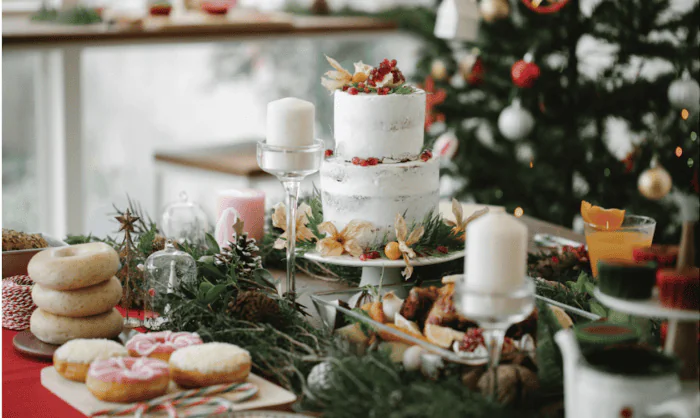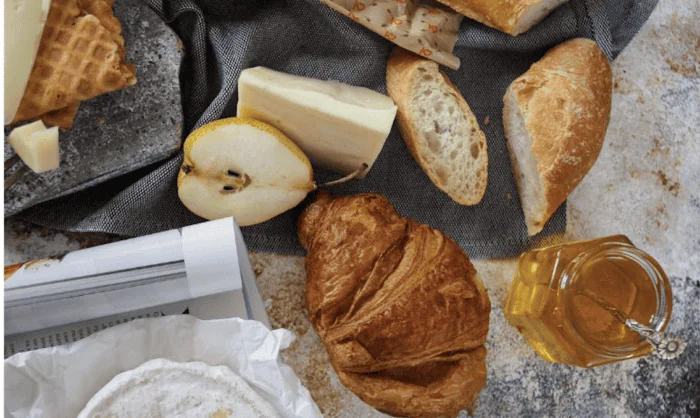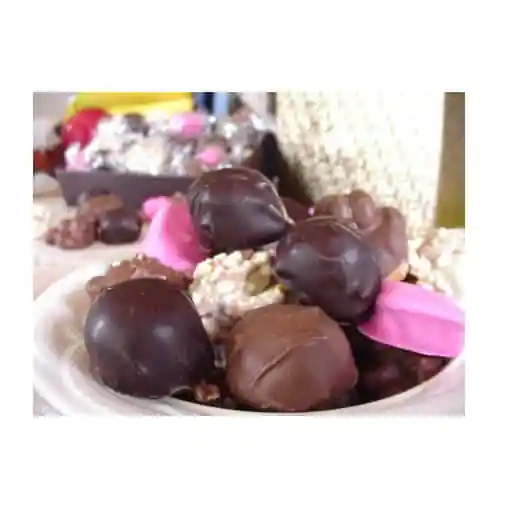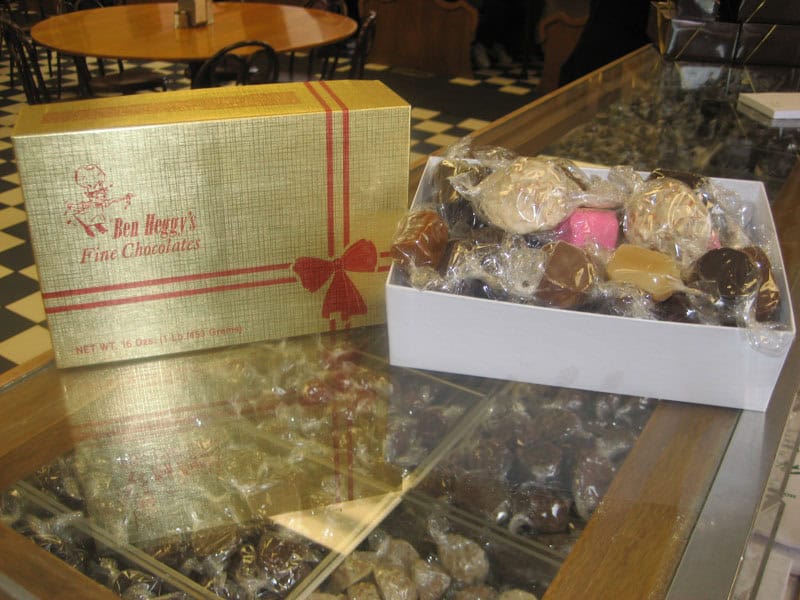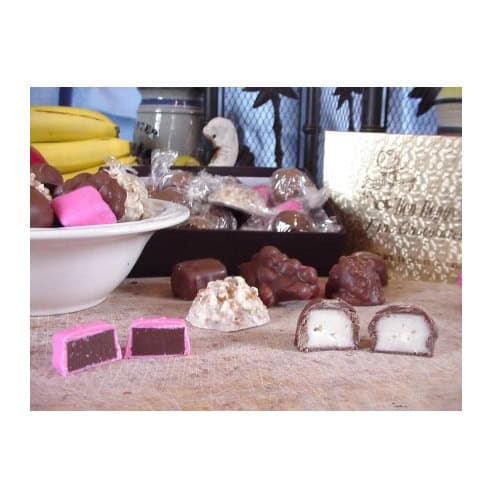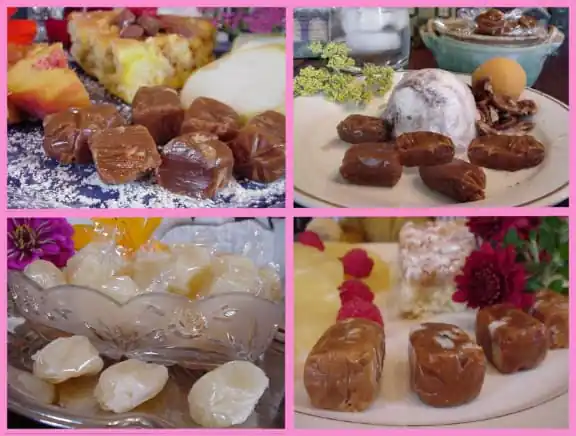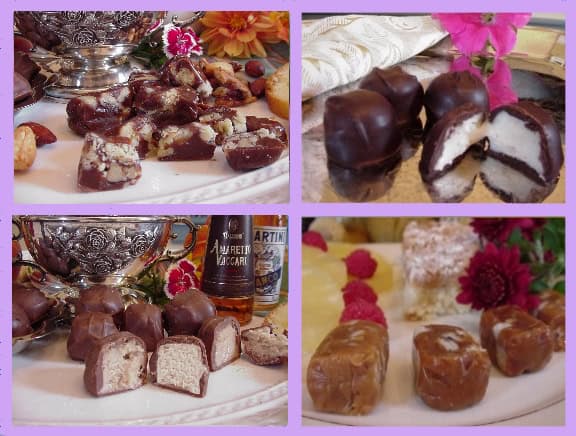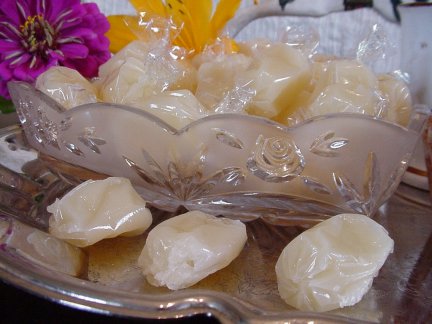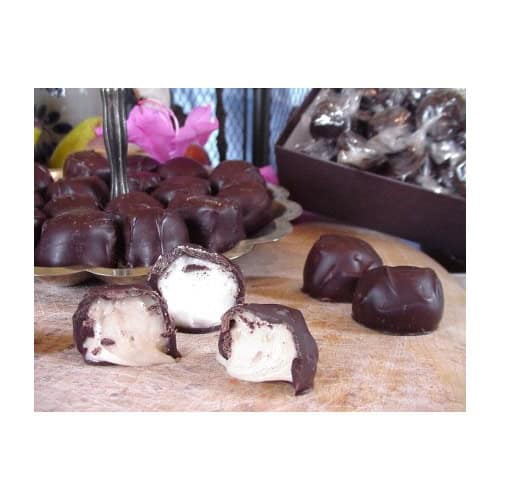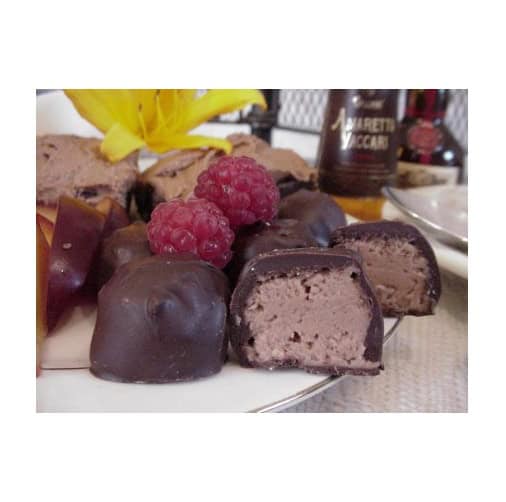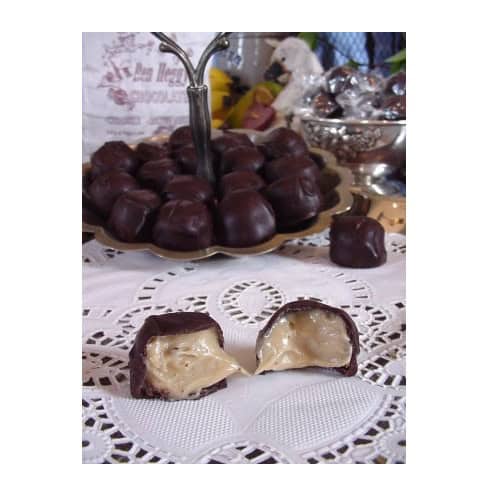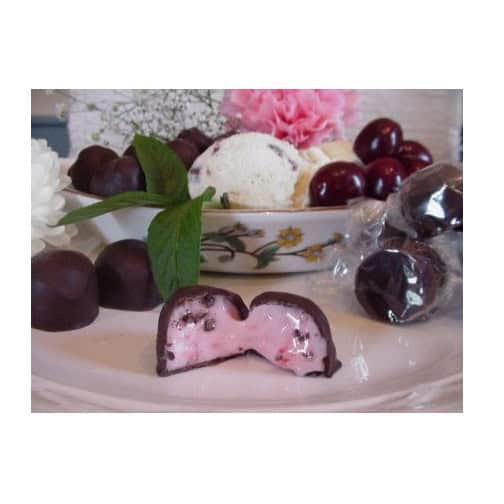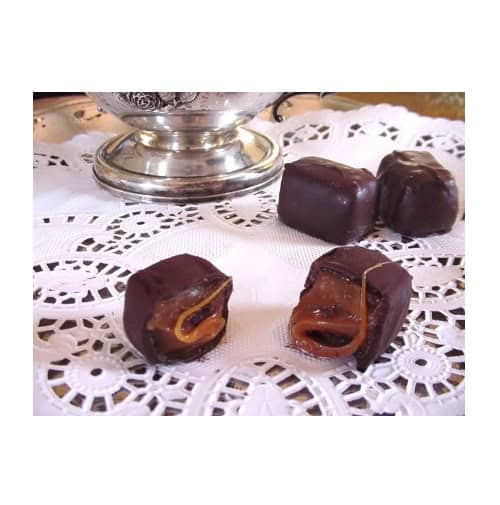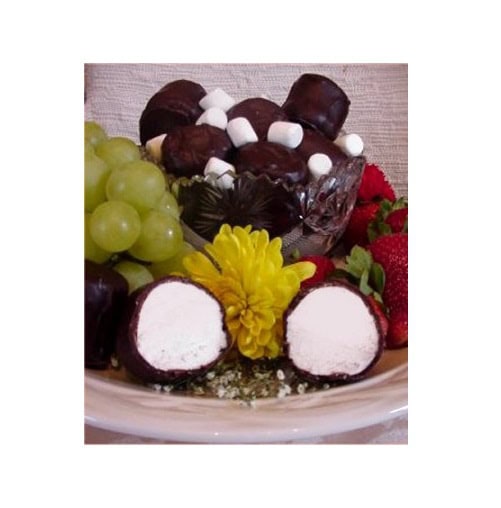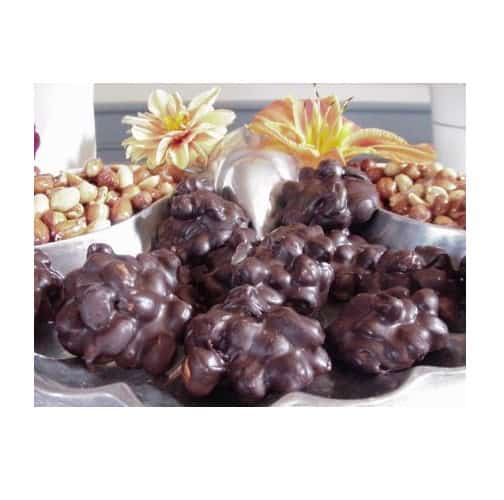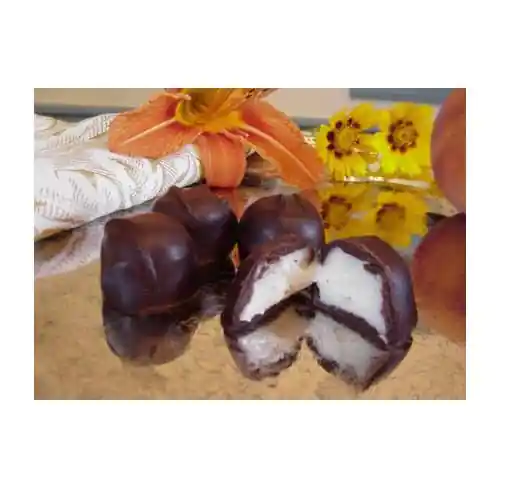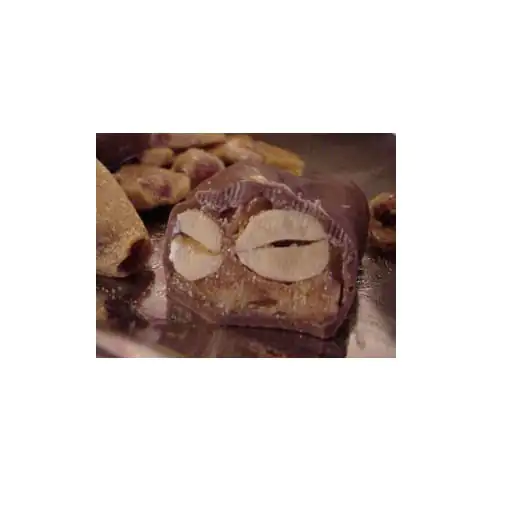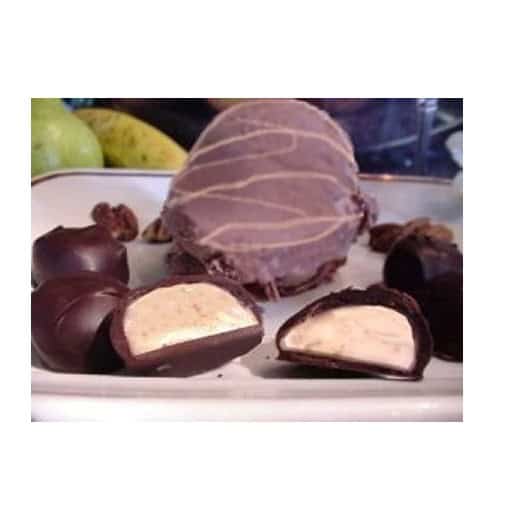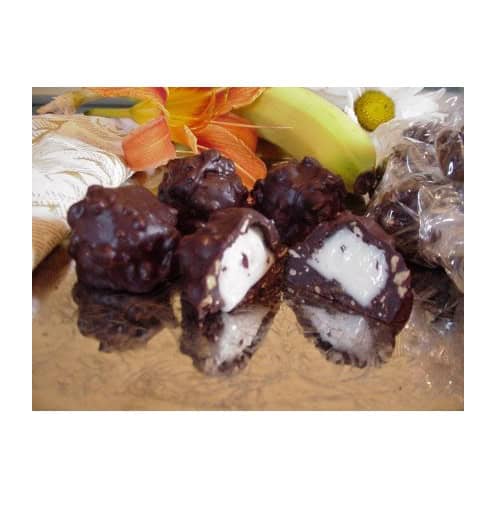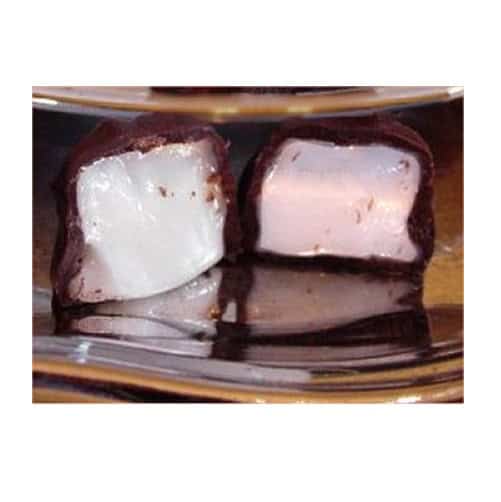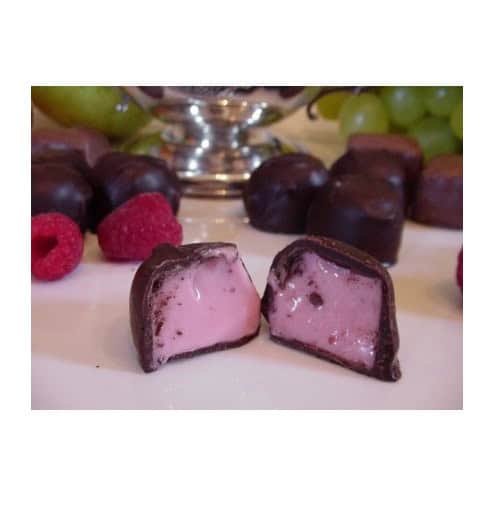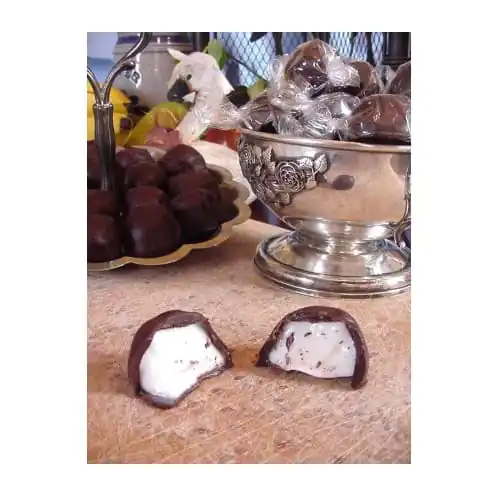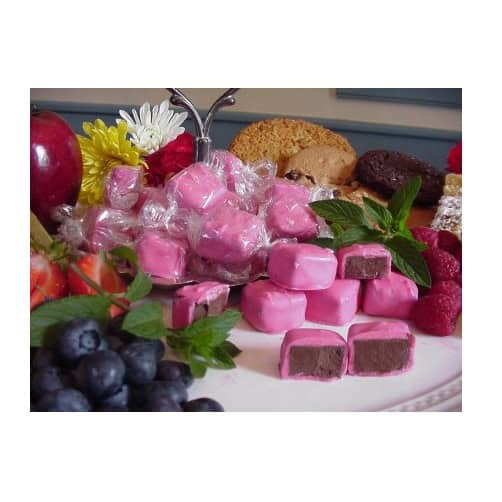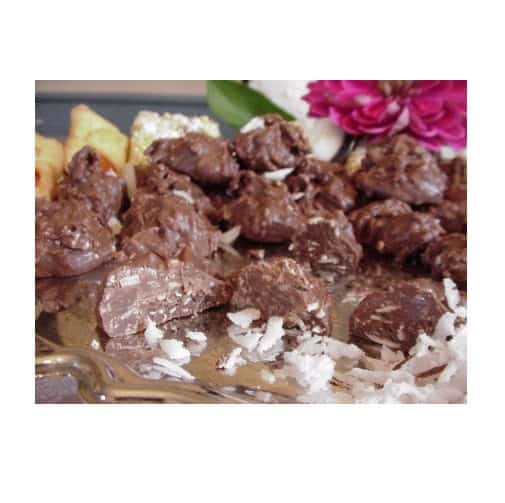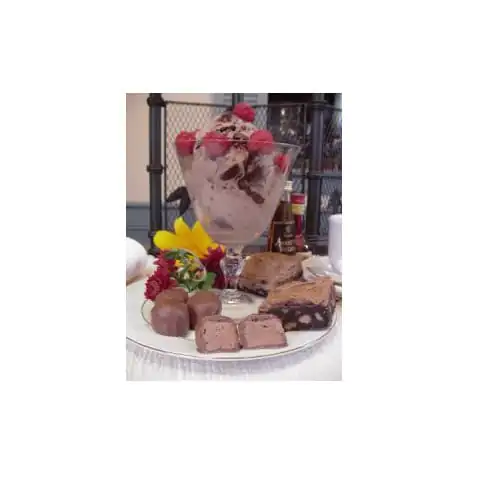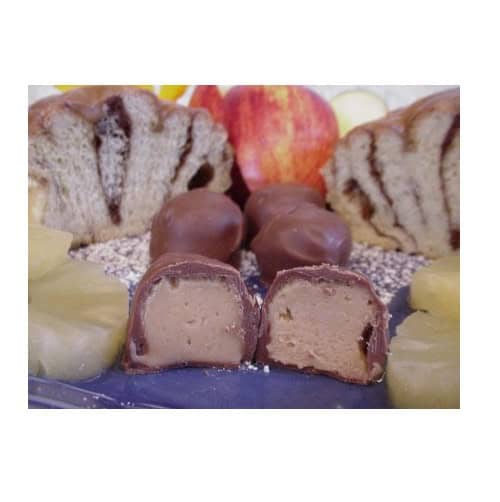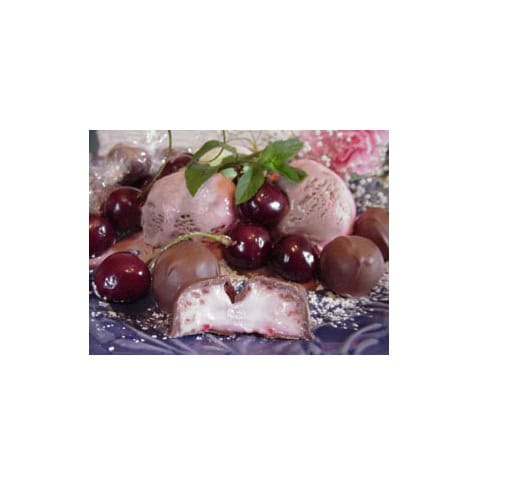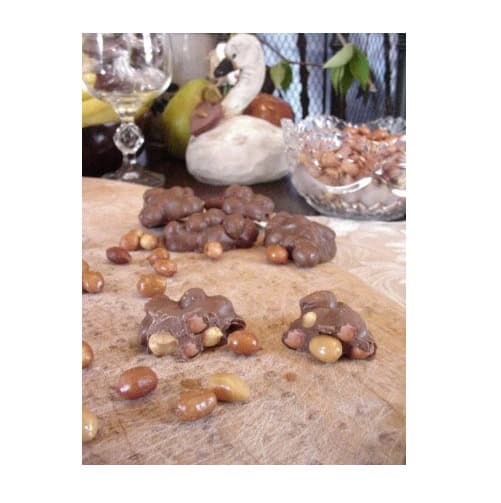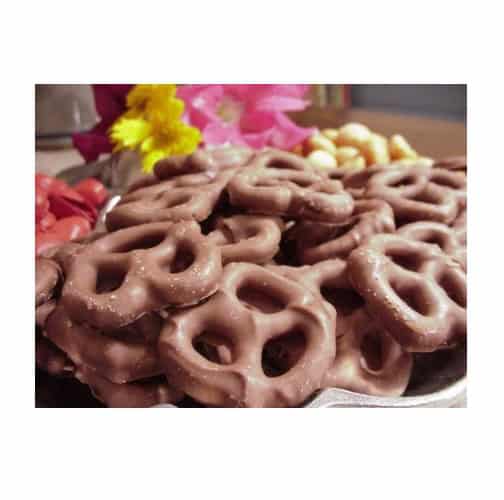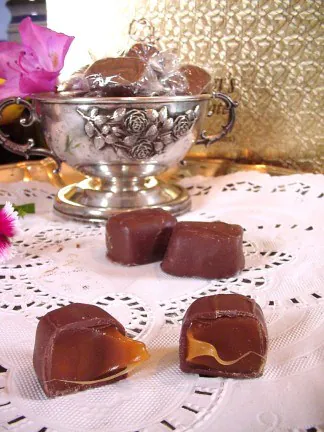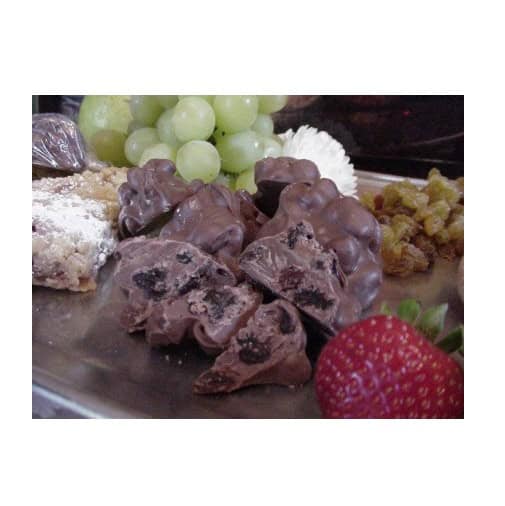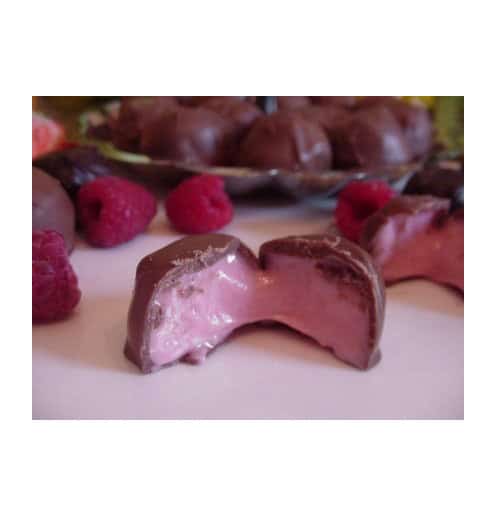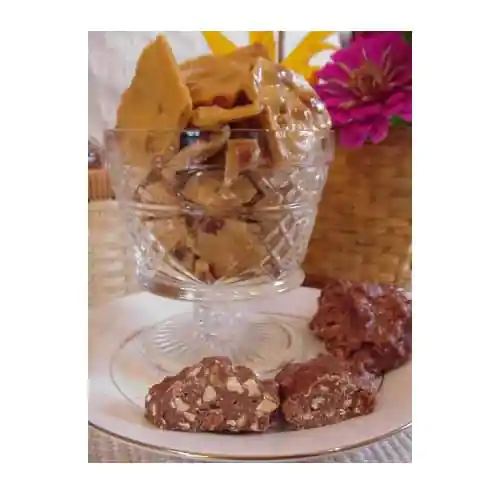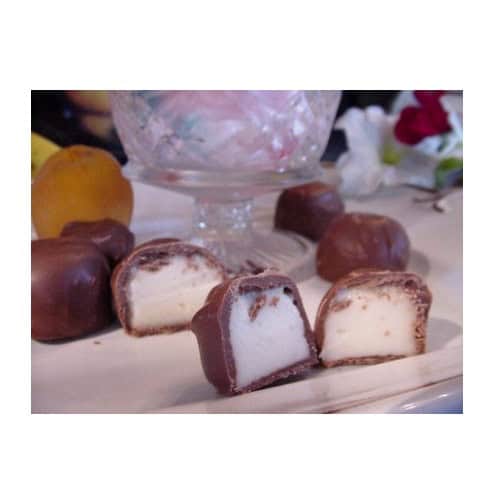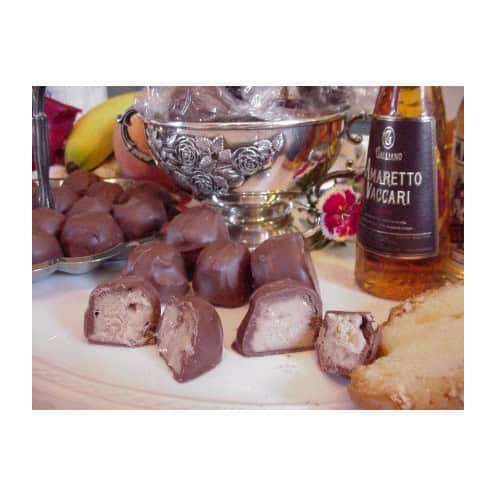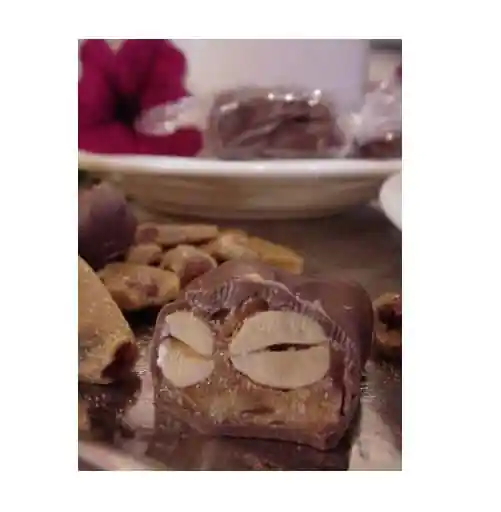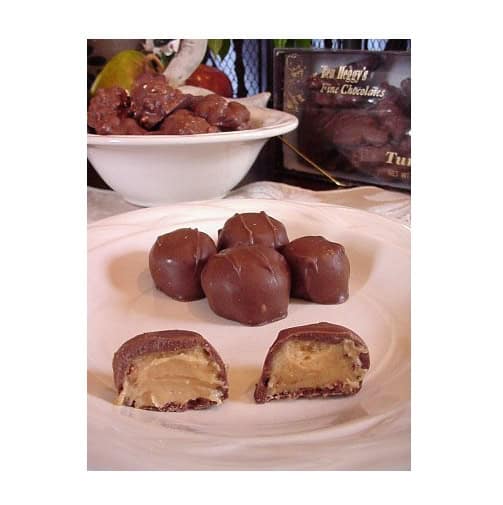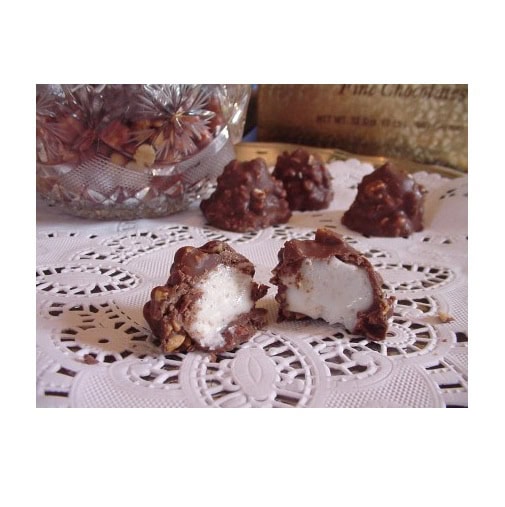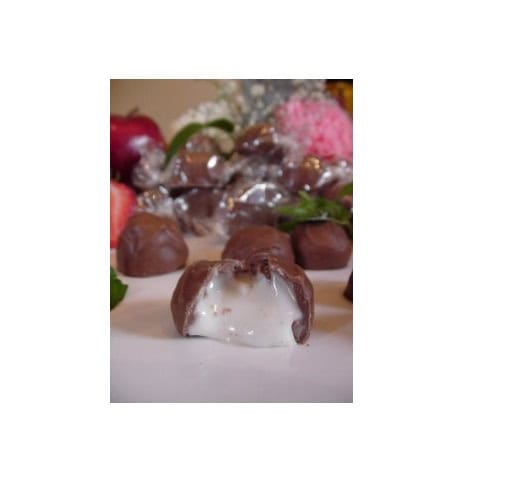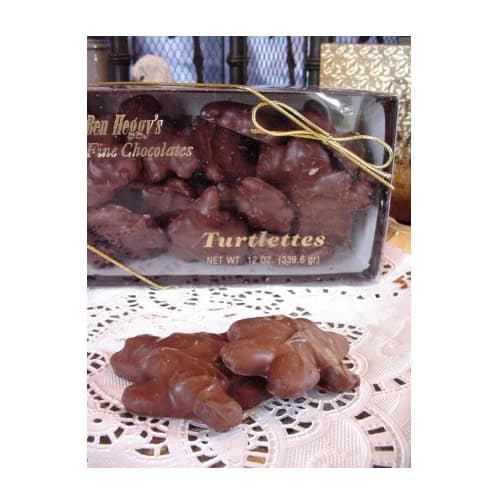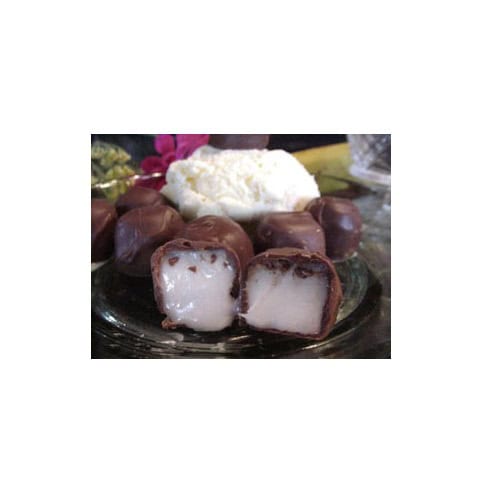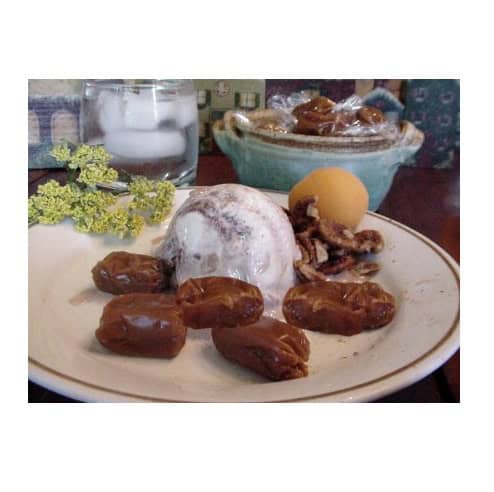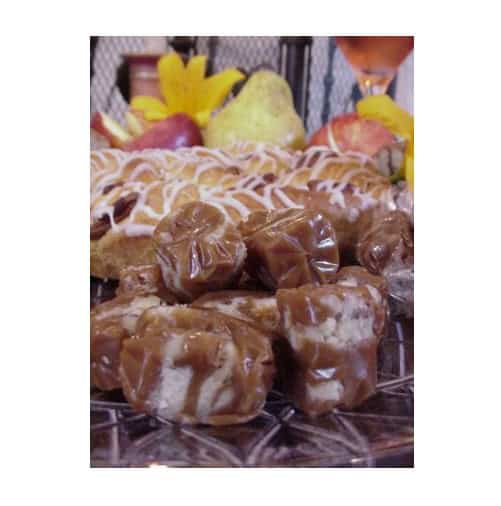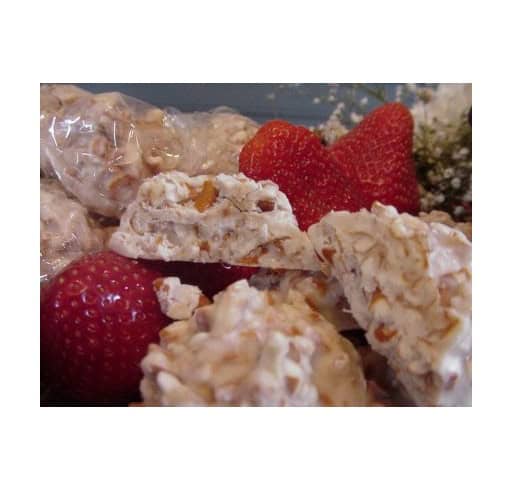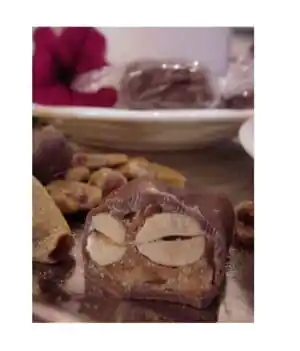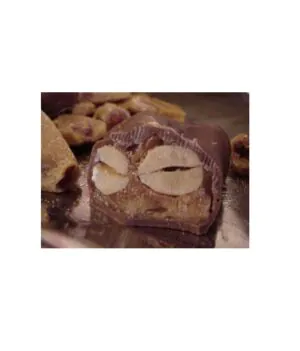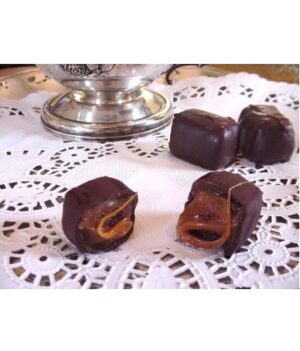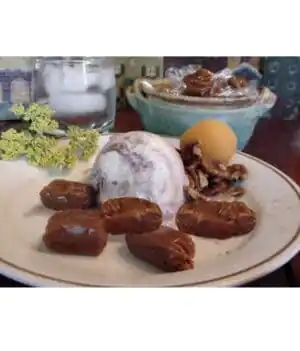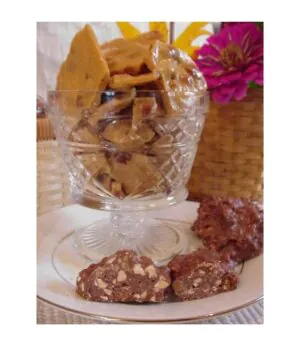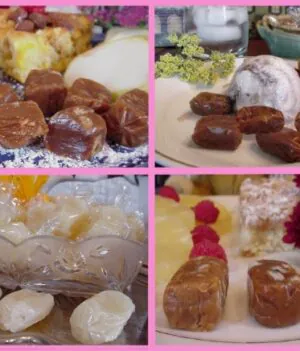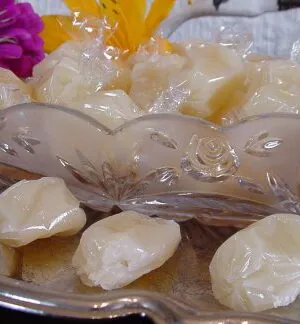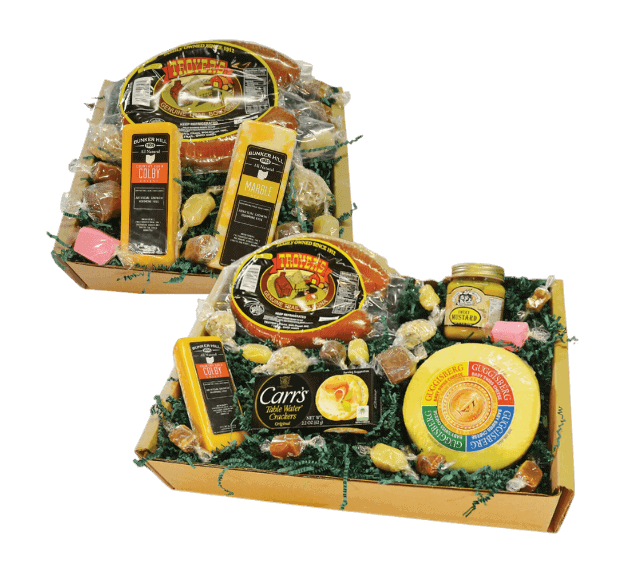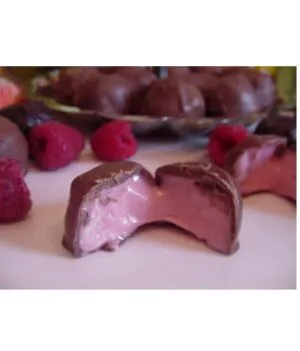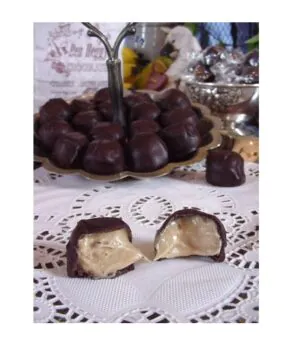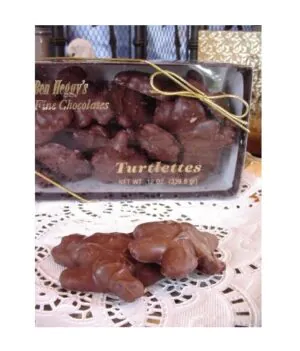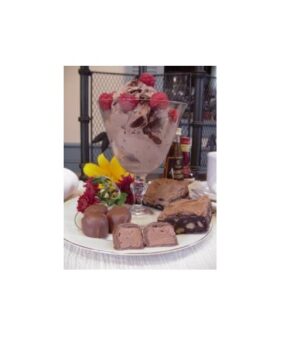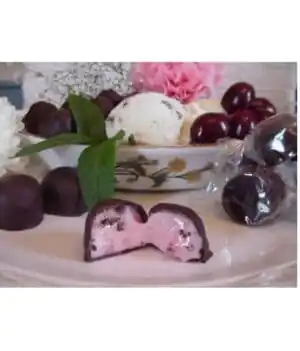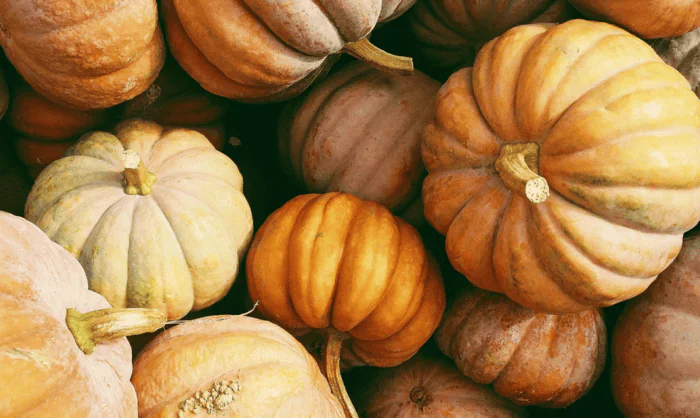Search Results for: nuts
How To Create a Christmas Sweet Treat Table
How To Create a Christmas Sweet Treat Table
Transform your celebration into a magical experience with a Christmas sweet treat table showcasing the season’s finest flavors.
This table will captivate your guests, from indulgent chocolates to sugar-free delights, offering something for every taste. Here’s your ultimate guide to crafting a dessert spread featuring Heggy’s signature confections and creative tips to elevate the presentation.
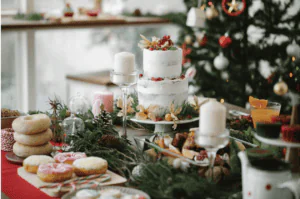
Choose the Star Treats
Your sweet table’s charm lies in the selection of irresistible treats. For a balanced mix, include:
- Chocolate buckeyes: These peanut butter and chocolate delights are a classic crowd-pleaser.
- Heggy’s haystacks: A crunchy, sweet-salty combination of pretzels coated in creamy chocolate.
- Heggy’s milk chocolate brownie creams: Luxuriously rich and perfect for brownie lovers.
- Heggy’s chocolate-covered raspberry creams: A fruity twist wrapped in decadent chocolate.
- Heggy’s milk chocolate peanut clusters: Nutty, crunchy, and satisfyingly sweet.
- Sugar-free mint meltaways: Guilt-free treats with a refreshing minty flavor.
- Sugar-free chocolate caramels: A chewy, indulgent delight minus the sugar.
- Heggy’s walnut caramels: A perfect addition for texture and flavor variety.
Plan the Presentation
A well-curated layout makes your table a visual and gastronomic delight. Here’s how to arrange it:
1. Choose a theme
Go for a festive theme, like “Winter Wonderland” with snow-white accents, or “Traditional Christmas” featuring reds, greens, and gold. Use themed tablecloths, runners, or garlands to set the tone.
2. Vary heights and layers
Use cake stands, tiered platters, and decorative bowls to create levels. This not only adds visual interest but also makes the treats more accessible.
3. Divide and conquer
Group similar items together for easy navigation. Arrange chocolates, sugar-free options, and nuts in distinct sections with labeled name cards for an elegant touch.
Add Extra Festive Flair
Add in decorative elements to tie the look together:
- Twinkling lights: String fairy lights around the table for a magical glow.
- Seasonal greenery: Add sprigs of pine, holly, or rosemary to bring natural warmth.
- Edible decorations: Use candy canes, gingerbread cookies, or chocolate ornaments to accent the table.
Sweet Pairings
Complement your treats with beverages like hot cocoa, coffee, or spiced cider. Think about creating a mini drink station beside the table for added convenience.
Accommodate Dietary Needs
Adding sugar-free options makes sure no one feels left out. Clearly label these items to guide guests with dietary preferences or restrictions.
Encourage Takeaways
Provide festive goodie bags so guests can take a piece of the magic home. Add personalized tags so that everyone feels special.
Final Touches
Before the party, make sure everything is neatly arranged and fresh. Refill empty spaces as guests enjoy the treats to keep the table looking inviting.
With a touch of creativity and the delicious charm of our confections, your Christmas sweet treat table will become the highlight of the holiday celebration. Let this joyful spread bring smiles, sweet memories, and festive cheer to your home!
The Ultimate Christmas Wreath With Cheese
Looking for a show-stopping appetizer that’s as pretty to look at as it is to eat? This Christmas wreath with cheese is the perfect centerpiece for your holiday gathering.
Made with a medley of cheeses, fresh herbs, and seasonal garnishes, it’s easy to assemble and irresistibly delicious.

If you loved this recipe, check out our Christmas breakfast ideas, plus this recipe for white cheddar and apple scones.
Recipe
Here’s what to round up to make this festive Christmas wreath with cheese, plus the exact steps to making it:
Ingredients
- 8 oz cream cheese, softened
- 4 oz goat cheese
- 1 cup shredded sharp cheddar cheese
- 2 tbsp fresh chives, chopped
- 1 tsp garlic powder
- 1/2 tsp smoked paprika
- Fresh herbs for garnish (rosemary, thyme, parsley)
- Cherry tomatoes or red grapes (for “berries”)
- Crackers, breadsticks, or veggie sticks for serving
Optional toppings:
- Toasted nuts (like pecans or almonds)
- Dried cranberries
- Pomegranate seeds
Instructions
1. Mix the cheese base: In a mixing bowl, combine the cream cheese, goat cheese, shredded cheddar, chives, garlic powder, and smoked paprika. Use a hand mixer or spatula to blend until smooth and well combined.
2. Shape the wreath: Place a sheet of parchment paper on your serving platter. Spoon the cheese mixture onto the center and form it into a circular wreath shape, leaving a hollow center. Smooth the edges using a spatula or damp hands.
3. Chill the wreath: Refrigerate the cheese wreath for at least 1 hour to firm up. This makes it easier to decorate and serve.
4. Decorate with herbs and garnishes: Remove the wreath from the fridge and carefully transfer it to your serving platter (if it isn’t already there). Arrange sprigs of fresh rosemary, thyme, or parsley around the edges of the cheese ring to mimic evergreen branches.
5. Add holiday “berries”: Use cherry tomatoes or red grapes as your “berries,” tucking them in among the herbs. For extra sparkle, add pomegranate seeds or sugared cranberries.
6. Finish with optional toppings: Sprinkle toasted nuts or dried cranberries over the top for added texture. You can even drizzle a little honey for a sweet-savory touch.
7. Serve and enjoy: Surround your cheese wreath with an assortment of crackers, breadsticks, or veggie sticks for dipping and spreading. Encourage guests to scoop up a little of everything for a burst of flavor in every bite.
Tips for Success
Here are our tips for getting the best results:
- Make ahead: Prepare the cheese wreath up to two days in advance and decorate just before serving.
- Customize the flavors: Swap out cheddar for Gouda or add crumbled blue cheese for an extra punch.
- Keep it fresh: Garnish with herbs right before serving to keep them vibrant.
This Christmas wreath with is more than an appetizer—it’s a conversation starter. Whether you’re hosting a cozy family gathering or an elegant holiday soirée, it’s guaranteed to bring smiles and festive cheer to your table.
Serving Idea:
Pair the wreath with a glass of sparkling wine or your favorite holiday mocktail for an elevated experience. Cheers to the holidays and happy entertaining!
Christmas Breakfast Ideas With Cheese
Christmas Breakfast Ideas With Cheese
Make a festive spread to remember with our Christmas breakfast ideas with cheese. From sweet to savory, this list will have you covered!
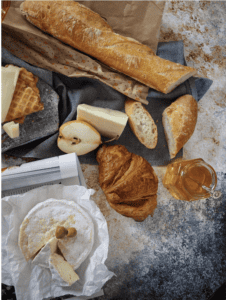
Savory Options
- Cheesy egg and sausage casserole
A hearty baked dish layered with eggs, breakfast sausage, and loads of shredded cheddar or Gruyère. - Cheese-stuffed croissants
Flaky croissants filled with brie, cream cheese, or Gruyère, baked until golden. - Spinach and cheese breakfast strata
A layered bread casserole with spinach, eggs, and a mix of Parmesan and mozzarella. - Cheddar and chive scones
Fluffy scones packed with sharp cheddar and a touch of fresh chives. - Caprese breakfast sandwich
Fresh mozzarella, tomato slices, basil, and a drizzle of balsamic glaze on a toasted English muffin. - Ham and cheese puff pastry pockets
Puff pastry filled with diced ham, cream cheese, and Swiss or Gruyère. - Cheesy potato hash
Crispy potatoes tossed with melty cheddar or Pepper Jack and topped with poached eggs. - Baked brie and cranberry pastry cups
Mini puff pastry cups filled with brie, cranberry sauce, and a sprinkle of pecans. - Cheese and herb frittata
A simple yet elegant egg dish with goat cheese, feta, or ricotta and fresh herbs. Mix in a little pumpkin butter into the egg filling. - Everything bagel breakfast pizza
Bagel halves topped with cream cheese, scrambled eggs, cheddar, and bacon crumbles.
Sweet Cheese-Inspired Options
- Ricotta pancakes with honey
Light and fluffy ricotta pancakes drizzled with honey and topped with fresh berries. - Cheesecake-stuffed French toast
Thick slices of bread filled with sweetened cream cheese and dusted with powdered sugar. - Cheese Danish pastries
Classic puff pastry filled with sweetened cream cheese and topped with fruit or jam. - Apple and brie Puff pastry braid
A stunning breakfast centerpiece filled with brie, thinly sliced apples, and a touch of cinnamon sugar. - Savory- sweet cheese board
A breakfast twist on a charcuterie board featuring soft cheeses, fruits, nuts, bagels, and spreads.
Our Top Tips for a Festive Spread
We’ve broken these up into menu and general tips:
Tips for a Great Christmas Breakfast Menu
- Plan a balanced menu: Include a mix of sweet and savory items. For example, pair pancakes or pastries with egg-based dishes or casseroles. Add a variety of textures: crispy (bacon, croissants), creamy (yogurt, cheeses), and fluffy (waffles, frittatas).
- Incorporate holiday colors: Use red and green ingredients like cranberries, pomegranates, strawberries, spinach, and basil to create a festive look. Garnish dishes with edible holiday touches such as rosemary sprigs or powdered sugar “snow.”
- Have that one showstopper dish: Make one centerpiece dish, like a baked brie wreath or a Christmas tree-shaped pull-apart bread, to wow your guests.
- Prepare ahead: Choose recipes that can be made or prepped the night before, like breakfast casseroles, overnight oats, or muffin batter. Lay out serving dishes, utensils, and decorations the evening prior.
- Incorporate cheese: We are biased, but….everyone loves cheese! Right? Check out our full range here.
- Serve seasonal drinks: Prepare a festive beverage menu featuring items like cranberry mimosas, eggnog, or spiced apple cider.
- Keep portions small: Offer bite-sized portions for variety and ease, such as mini quiches, slider-style breakfast sandwiches, or muffin tin casseroles.
- Use decorative serve ware: Go for holiday-themed plates, napkins, and serving trays to tie the theme together.
- Have DIY options: Set up stations:
- Bagel bar: Include cream cheese, smoked salmon, sliced veggies, and festive toppings.
- Pancake or waffle station: Offer syrups, fresh fruit, whipped cream, and sprinkles.
- Hot chocolate bar: Provide cocoa, marshmallows, whipped cream, peppermint sticks, and chocolate shavings.
General Tips for a Great Christmas Breakfast
- Make it interactive: Include a group activity to enhance the experience, like decorating Christmas cookies or building a gingerbread house after breakfast.
- Label dishes: Add small cards to identify each dish, mainly if you include allergy-friendly or gluten-free options.
- Add personal touches: Include handwritten thank-you notes or mini Christmas crackers at each place setting to make guests feel special.
- Don’t forget the kids: Offer kid-friendly options like fruit skewers, yogurt parfaits, or Christmas-shaped pancakes with fun toppings.
Thanksgiving Cheese Ideas For Kids
Thanksgiving Cheese Ideas for Kids
If you’re hunting for Thanksgiving cheese ideas for kids, we’ve got you! When setting up the Thanksgiving table, cheese is an easy and popular snack choice. Typically, kids love cheese just as much as adults, so don’t leave them out!
This year, try out one or two of these fun and easy Thanksgiving cheese ideas for kids. Choose snacks that are festive, tasty, and perfect for little hands.

Cheese Turkeys
Cheese turkeys are a playful way to bring a touch of Thanksgiving spirit to snack time. To make these adorable treats, all you need are cheese rounds, veggie slices, and pretzel sticks.
Here’s how to create your own cheesy turkeys:
- Prepare the cheese rounds: choose something like Brick cheese that you can slice and can into rounds. This works well for this project. Place one cheese round per turkey on a platter.
- Add pretzel “feathers”: insert small pretzel sticks into the top half of the cheese round to create feather-like fanning behind the turkey’s head.
- Decorate with veggies: use a small slice of carrot for the turkey’s beak and black olives or edible markers for eyes.
- Add “wattles”: a small piece of red pepper or dried cranberry works perfectly to give your turkey that Thanksgiving charm.
Kids can even help assemble their own cheese turkeys, adding a personal touch to the display. Arrange the turkeys on a tray with additional veggie sticks and crackers to create a Thanksgiving-themed snack platter that’s both fun and delicious.
Mini Cheese Logs
Cheese sticks are a holiday classic, but turning them into mini versions on a stick makes them extra fun and easy for kids to enjoy.
These bite-sized treats are perfect for little hands, and the different coatings give each one a unique flavor and look. Here’s how to make your own platter of mini cheese balls on a stick.
Ingredients
- 8 oz. cream cheese or goat’s cheese, softened
- 1 cup shredded white cheddar cheese
- 1 tsp garlic powder
- 1 tsp onion powder
- Salt and pepper to taste
- Toppings for rolling (chopped nuts, dried cherries, fresh herbs like parsley or chives)
- Mini skewers
Instructions
- Make the cheese mixture: In a bowl, combine the cream or goat’s cheese, shredded cheddar, garlic powder, onion powder, salt, and pepper. Mix well until everything is evenly combined and smooth.
- Form the cheese logs: Use a spoon to scoop small portions of the cheese mixture, then roll each into a oblong log shape with your hands.
- Roll in toppings: Set out small bowls of your toppings (chopped nuts, dried cranberries, herbs) and roll each cheese ball in your choice of coating. For a festive look, create a variety platter by using different toppings for different balls.
- Assemble with sticks: Insert a toothpick or mini skewer into each cheese log to make it easy for kids to grab.
Arrange the mini cheese logs on a platter, alternating between the different coatings to create a colorful display. These little snacks are perfect for a Thanksgiving party or a family gathering, giving kids the chance to try new flavors while enjoying a familiar treat.
Cheese and Fruit Kabobs
If your kids like fruit, adding it to cheese on a kabob is a surefire way to make it even more appealing. Use cubes of mild cheese, like cheddar or mozzarella, and pair them with kid-friendly fruits like grapes, strawberries, or pineapple.
Simply thread the cheese and fruit onto small skewers or toothpicks, alternating between the two for a fun and nutritious snack. This snack is quick to assemble and can be tailored to include your kids’ favorite fruits.
These kid-friendly cheese snacks bring holiday joy to the table with minimal fuss and lots of fun. They’re easy to make, visually festive, and, best of all, they help make holiday gatherings more inclusive and enjoyable for everyone—even the smallest guests!
Wrapping It Up
We hope this post brought you some family fun inspiration! Don’t forget to check out our selection of cheeses here, plus our selection of accompaniments.
Seasonal Cheese Pairings: What to Enjoy Each Season
Seasonal Cheese Pairings: What to Enjoy Each Season
Seasonal cheese pairing comes naturally if you think about it. Each season has its own set of classic tastes and textures that can be linked to specific cheeses. Knowing which ingredients complement which cheese helps you create an unforgettable experience.
Here’s a guide to cheese pairings that bring out the best of each season, with ideas to inspire your table year-round.
Spring: Fresh and Zesty
Spring is a time for renewal, and fresh flavors dominate as gardens burst to life. Soft cheeses like chèvre (goat cheese), ricotta, and mozzarella work beautifully with spring’s bounty. Chèvre’s tangy notes blend perfectly with ingredients like sweet, dried strawberries or fresh peas.

Pairing idea: A spring cheese board with chèvre, strawberries, sugar snap peas, mixed nuts, and a drizzle of honey. Add a handful of toasted almonds or a few sprigs of mint for added freshness. Pretty-up your board with edible spring flowers like nasturtiums.
For something more savory, layer ricotta or goat’s cheese on toast and top it with sliced radishes, cracked black pepper, and a sprinkle of sea salt. The peppery bite of radish against creamy ricotta creates a balanced flavor that screams spring.
Summer: Bright and Juicy
Summer’s bounty brings vibrant, juicy produce that begs to be paired with creamy, mild cheeses. Yogurt cheese and double cream gouda are excellent choices for hot-weather dishes. Yogurt cheese’s creamy, milky interior pairs beautifully with tomatoes and fresh basil. Gouda, on the other hand, is tastyb with rich, sun-ripened fruits like watermelon and peaches.

Pairing idea: Make a summery salad by tossing chunks of juicy watermelon, gouda, fresh mint, and a sprinkle of black sesame seeds.
For an extra touch, drizzle some balsamic glaze over the top.
Alternatively, use yogurt cheese in a simple Caprese salad (instead of traditional fresh mozzarella) with ripe tomatoes, fresh basil, and a drizzle of olive oil. Serve with crusty bread for a Mediterranean-inspired pairing perfect for balmy summer evenings.
Fall: Earthy and Warm
As the leaves turn and temperatures drop, it’s time to embrace hearty, earthier flavors. Garlic cheddar, gruyère, and blue cheese all complement the cozy, nutty taste of fall produce. Apples, pears, figs, and nuts are natural companions to these cheeses, enhancing their rich, layered flavors.
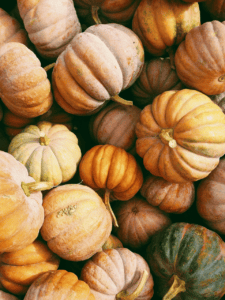
Pairing idea: For a seasonal cheese board, pair the cheddar with apple butter, pumpkin butter, cinnamon almonds, and a dollop of fig jam. The combination of sweet, tangy, and savory flavors is autumn on a plate.
Another idea is to make a warm, gooey gruyère fondue with cubed roasted squash, mushrooms, and hearty bread on the side.
The earthy, caramelized flavors of the roasted vegetables add a rustic depth to the creamy cheese.
Winter: Rich and Indulgent
Winter calls for cheeses with deep, robust flavors that match the season’s indulgence. Provolone, camembert, and pecorino offer comforting richness that works well with winter fruits like pomegranates, citrus, cranberries, and dried figs.
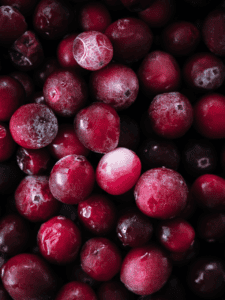
Warming spices like cinnamon and cloves also add holiday charm to cheese pairings.
Pairing idea: Baked camembert topped with blackberry pecan syrup, toasted cashews, and a drizzle of honey is a classic winter dish that combines sweet, tart, and creamy textures. Serve with sliced baguette for a crowd-pleaser at any holiday gathering.
Or, try a wedge of pecorino with blood orange slices, arugula, and a light vinaigrette for a simple yet luxurious winter salad that balances the cheese’s sharpness with citrusy brightness.
Bringing It All Together
Cheese pairings don’t have to be complicated—let the season’s ingredients guide you.
From fresh spring berries to hearty winter nuts and fruit, seasonal pairings allow you to enjoy cheese at its peak and celebrate the flavors of each season.
Experiment with local produce and some of our cheeses, and you’ll discover new combinations that make each season a little more delicious.
Best Cheeses from Around the World: A Journey Through International Cheese Varieties and Their Origins
The best cheeses are found in all four corners of the world. Cheese is more than just a delicious food type – it is a universal (love) language that almost every culture embraces in its cuisine.
Each variety tells a story, carrying centuries of tradition, local flavors, and the essence of the regions they hail from. Let’s check out the most popular global cheeses and a bit about each cheese:
France: Brie – The King of Cheese

Beautiful French Town
France is synonymous with fine cuisine, and its cheese is no exception. Among the many varieties, Brie is probably the most well-loved.
Originally from the Île-de-France region, this soft, creamy cheese has been enjoyed since the 8th century.
It is known for its delicate, bloomy rind and buttery flavor. Brie’s versatility makes it a favorite on cheeseboards and gourmet dishes.
Whether paired with fruits and nuts or melted into pastries, Brie exemplifies French sophistication.
Italy: Parmigiano Reggiano – The Pride of Parma
When it comes to Italian cheese, Parmigiano Reggiano reigns supreme. Often referred to as the “King of Cheeses,” this hard, crumbly delicacy is produced in the Emilia-Romagna region. It’s one of the best cheeses to top pasta with!
Its production follows strict guidelines to ensure authenticity. It has a maturation process lasting up to 36 months.
The result is a complex, nutty flavor with a salty kick, perfect for grating. It’s also a delicious snack with a splash of balsamic vinegar. Parmigiano Reggiano is a testament to Italy’s dedication to quality and tradition.
Switzerland: Emmental – The Classic Swiss Cheese

Swiss goat
When most people think of Swiss cheese, they are picturing Emmental. This is the iconic cheese with holes. Originating from the Emmental Valley in Switzerland, this cheese has a mild, slightly nutty flavor and smooth, firm texture.
The distinctive holes are formed during the fermentation process, making Emmental instantly recognizable. Whether melted in a fondue pot or layered in a sandwich, this cheese brings a touch of Swiss charm to any meal.
Spain: Manchego – The Jewel of La Mancha
From the sun-drenched plains of La Mancha, Spain, comes Manchego, a firm and buttery cheese made from sheep’s milk. This cheese dates back to the Bronze Age, and its distinctive flavor reflects the arid, grassy landscape where the Manchega sheep graze.
With its nutty, slightly sweet taste and crumbly texture, Manchego pairs beautifully with quince paste and cured meats. It is a cornerstone of Spanish cuisine and an ambassador of the country’s rich culinary heritage.
England: Cheddar – A Global Favorite
While Cheddar is now produced worldwide, its origins trace back to the village of Cheddar in Somerset, England.
This versatile cheese comes in various stages of maturity, from mild and creamy to sharp and tangy. Cheddar has a firm texture and a complex flavor profile, making it a popular choice for everything from sandwiches to gourmet cooking.
The traditional method of making cheddar involves “cheddaring,” a process that gives the cheese its unique structure and taste. Today, it remains a staple on cheeseboards and in kitchens globally.
Greece: Feta – A Mediterranean Treasure
No exploration of international cheeses would be complete without Feta, the crumbly, tangy cheese that has been a part of Greek culture for thousands of years.
Feta is made from sheep’s milk or a mixture of sheep’s and goat’s milk, and it is brined with a characteristic saltiness. Its firm yet creamy texture makes it perfect for salads, especially the classic Greek salad, and its bright flavor is a hallmark of Mediterranean cuisine.
Wrapping Up: The Best Cheeses
Cheese is a passport to the world, with each variety offering a taste of its homeland. From the rolling hills of France to the sun-soaked plains of Spain. These cheeses showcase the diversity of cultures and traditions that have shaped them.
Whether you prefer the creamy decadence of Brie or the bold tang of Feta, exploring international cheese varieties is a journey. We hope this post enriched your understanding of global culinary traditions.
Lastly, next time you reach for a wedge of cheese, remember that you’re not just enjoying a snack – you’re savoring a piece of history. Learn more about our business here and why we love what we do!
The Ultimate Guide to Different Cheeses: Explore Various Cheese Categories
Let’s explore the different cheeses and their types. From soft, creamy bries to sharp, tangy cheddars, the world of cheese is pretty exciting. Once you’re in, you’re in!
Whether you’re a newbie or a seasoned cheese lover, this guide will introduce you to the major cheese categories, helping you appreciate their unique characteristics and understand how best to enjoy them.
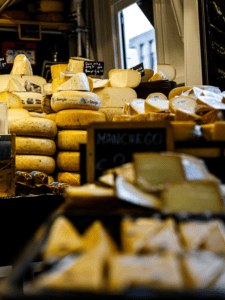
Types of cheese
Fresh Cheeses
Fresh cheeses are uncured and eaten soon after they are made—their high moisture content results in a soft, spreadable texture and a mild, milky flavor.
This is a good place to start if you’re stepping into the world of different cheeses.
A few examples include:
- Ricotta: Light, fluffy, and slightly sweet, ricotta is used in lasagnas, desserts, and breakfast dishes.
- Chevre (goat cheese): This versatile cheese has a tangy, earthy flavor and is delicious crumbled over salads or spread on crackers.
Soft-Ripened
Soft-ripened cheeses are characterized by their creamy interiors and bloomy rinds, which develop during the aging process.
These cheeses tend to have a delicate, buttery flavor that intensifies as they mature. Ones you’ve likely come across include:
- Brie: With its soft, velvety rind and rich, gooey interior, brie is a crowd-pleaser at any cheese board.
- Camembert: Similar to brie but with a stronger flavor, Camembert has a slightly mushroomy aroma and a lusciously smooth texture.
Semi-Soft
Semi-soft cheeses are usually more firm than fresh cheeses but still have a supple texture compared to this article’s other different cheeses.
Their flavors range from mild to pungent, depending on the aging process. Popular semi-soft cheeses include:
- Gouda: From the Netherlands, Gouda has a caramel-like sweetness and buttery finish. As it ages, it becomes firmer and more intense.
- Havarti: This Danish cheese has a smooth, creamy texture with a mild, tangy flavor, making it ideal for sandwiches or melting.
Hard
Hard cheeses are delicious when grated or sliced thinly.
Examples include:
- Parmesan (Parmigiano Reggiano): Revered as the “King of Cheeses,” Parmesan has a nutty, savory taste with crystals that add a delightful crunch. It’s essential for pasta dishes and risotto.
- Pecorino Romano: Made from sheep’s milk, Pecorino Romano is salty, sharp, and perfect for grating over pasta or adding a punch to savory dishes.
Blue
Blue cheeses have signature blue or green veins, created by adding mold cultures during production.
Their flavor can range from mildly tangy to intensely pungent. Well-known blue cheeses include:
- Gorgonzola: This Italian cheese offers a creamy texture with a rich, tangy flavor that pairs beautifully with honey, nuts, and pears.
- Roquefort: Made from sheep’s milk, Roquefort has a sharp, tangy bite and crumbly texture.
Washed-Rind Cheeses
Brine, beer, or wine bathing gives their cheese their strong aroma and a reddish-orange rind.
Despite their pungent smell, their flavor is often surprisingly mild and savory. Examples include:
- Taleggio: An Italian classic with a creamy texture and a fruity tang, Taleggio is excellent in risottos or melted on bread.
- Epoisses: A cheese from France, Epoisses is famously pungent but offers a smooth, rich, and slightly sweet flavor beneath its bold exterior.
Wrapping It Up
Cheese is a culinary treasure with endless possibilities for pairing and savoring. Whether you’re indulging in a creamy brie, a nutty gouda, or a robust Roquefort, each cheese type offers a unique sensory experience.
Next time you build a cheese board or cook a dish, experiment with different varieties to expand your palate and elevate your meals. Check out our full range for inspiration!
How To Host the Perfect Cheese and Wine Tasting at Home

Planning a memorable cheese and wine tasting at home can be a simple affair.
With the right selection of cheeses, wines, and a bit of creativity, you can create an experience that rivals the best wine bars.
Here are 5 steps to hosting an unforgettable evening of cheese and wine pairing.
- Select your cheeses and wines
First things first, you’ll need to pick your favorite cheeses – aim for different textures and flavors to keep things interesting.
A well-rounded selection might include:
- Soft cheeses:Brie, camembert
- Semi-hard cheeses:Gouda, cheddar
- Hard cheeses:Parmesan, Manchego
- Blue cheeses:Glacier wildfire blue cheese
For the wine, consider the following classic cheese and wine pairing options:
- Sparkling winewith brie or camembert
- Chardonnaywith gouda or cheddar
- Cabernet sauvignonwith parmesan or manchego
- Portwith blue cheese
Remember, the key to a great cheese and wine pairing is balance—matching the intensity of the cheese with that of the wine. Keep the process simple though and don’t overthink it too much.
If you want to get specific, here is our curated group of cheese to go with red wine and ones we recommend serving with white.
- Presentation is everything
Arrange your cheeses on a wooden board or a slate platter. Label each cheese, so your guests know what they’re tasting.
For added sparkle, include small bowls of nuts, dried fruits, chocolates, and honey—these can enhance the flavors of the cheese and wine.
- Guide your guests through the tasting
As part of the experience, guide your guests through the tasting process. Encourage them to start with a small bite of cheese, followed by a sip of wine, and then another bite of cheese to fully experience the interplay of flavors.

- Add in some fun pairing games
To keep it fun, consider blind tastings as a fun way to test your guests’ palates. This will be a cause for much giggling and fun. Cover the labels of the wines and have your guests guess which cheese pairs best with each one.
Another idea is to set up a “build-your-own” pairing station. Lay out an assortment of cheeses and wines and let your guests experiment with their combinations, noting which ones they enjoy the most. Prizes never hurt…
- Finishing touches
No cheese and wine pairing is complete without some thoughtful finishing touches. Offer plenty of water and neutral-flavored crackers to cleanse the palate between tastings.
Lastly, send your guests home with a little something to remember the evening by—whether it’s a small booklet with the cheese and wine pairing ideas you’ve explored together or a mini bottle of wine paired with a slice of cheese.
Wrapping It Up
Hosting a cheese and wine tasting at home is a really fun way to explore new flavors and create lasting memories with friends and family.
With the right pairings, thoughtful presentation, and a bit of creativity, you can turn a simple evening into a sophisticated and fun event. So gather your favorite cheeses, uncork some bottles, and let the tasting begin! Reach out to us to learn more about our range.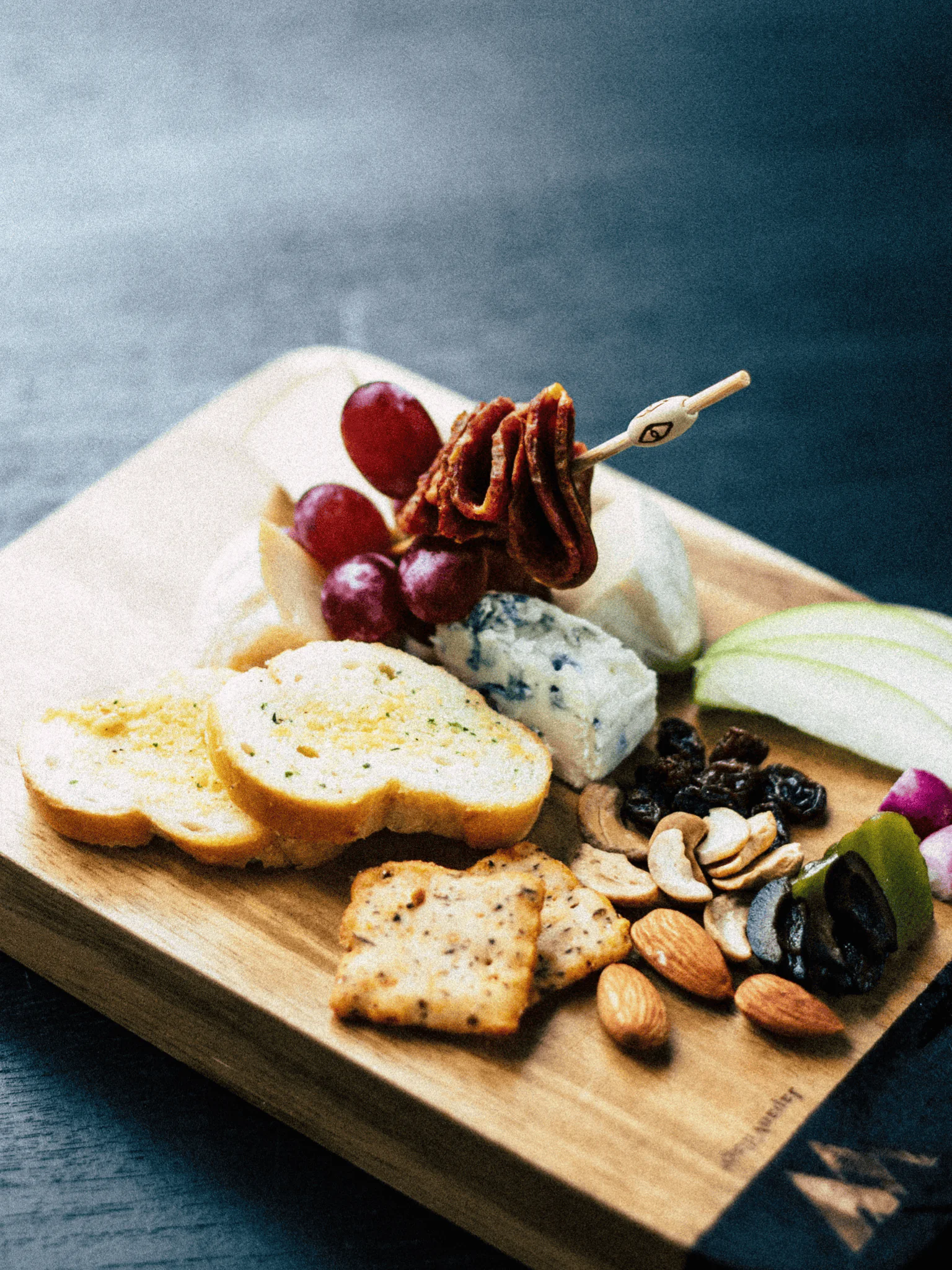
Build The Perfect Charcuterie Board
Build the perfect charcuterie board and cultivate confidence in entertaining.
A beautifully curated charcuterie board is a fun way to show off your meats and cheeses. Here’s how to create a real show-stopper!

Charcuterie board
What Belongs On a Charcuterie Board?
In terms of artistry and taste, creating a balance is key. You want a mix of sweet, savory, salty, and spicy flavors. Visually, create harmony by pairing various colorful and multi-textural ingredients together.
Meats
Cured meats are a key part of your board – try a mix of sliced salami, coppa, ham, or pancetta. Don’t forget to add pieces of sausage like bologna or summer sausage. Thick slices of chorizo add texture and a meaty bite. You could also pop on a pot of chicken liver pate or a terrine.
Cheeses
You want a balance of strong, creamy, tangy, and mild cheeses. Of course, camembert and gouda are popular, as is a lovely piece of blue cheese or manchego.
Don’t forget to add soft goat cheese or feta as a contrast to harder cheeses like pecorino or cheddar.
Accompaniments
Adding fresh fruits like grapes, sliced apples, figs, and berries adds sweetness and contrast to your charcuterie board.
Consider a sprinkle of nuts like toasted almonds or hazelnuts. Condiments like honey, fruit preserves, and jams are also at home on your board, as are mustard and pickles. Adding a few briney ingredients like olives or capers is lovely, too.
Choose two or 3 types of bread or crackers as the vehicles to load up all the tasty treats you’ve laid out. To cater to everyone’s tastes, consider multigrain, gluten-free, crusty, and plain white bread options.
Build The Perfect Charcuterie Board
- Choose your board: opt for a wooden or slate board, a marble slab, or even a large serving tray.
- Begin by placing small bowls on the board to hold condiments such as honey, mustard, or fruit preserves.
- Now, it’s time to arrange the meats. Do this in a way that allows easy access for guests to pick up slices without disturbing the overall presentation.
- Follow up by adding an assortment of cheeses.
- To complete the charcuterie board, add accompaniments that complement the flavors and textures of the meats and cheeses.
- Finally, fill any remaining empty spaces on the board with bread and crackers.
Be creative and use what is in season. Combine trendy ingredients with classic favorites, and everyone will want to tuck in.
Tips To The Best Charcuterie Board
- Adding color: fruits, flowers, and veggies all add pretty pops of color
- Vary the textures and shapes: arrange your meats and cheese in different shapes. Roll the slices, fold pieces, or cut cubes out.
- Choose complimentary pairings, for example:
- Sweet, sour, savory: try this Sour Cherry Bourbon Goat’s Cheese
- Tangy and creamy: pickles and olives with creamy cheeses
Remember, the key to taking your board to the next level is to think beyond the basics and incorporate elements that enhance both the visual appeal and taste experience.
Wrapping It Up
Take a look at our Products Page where you will find loads of options to choose from to build the perfect charcuterie board.

